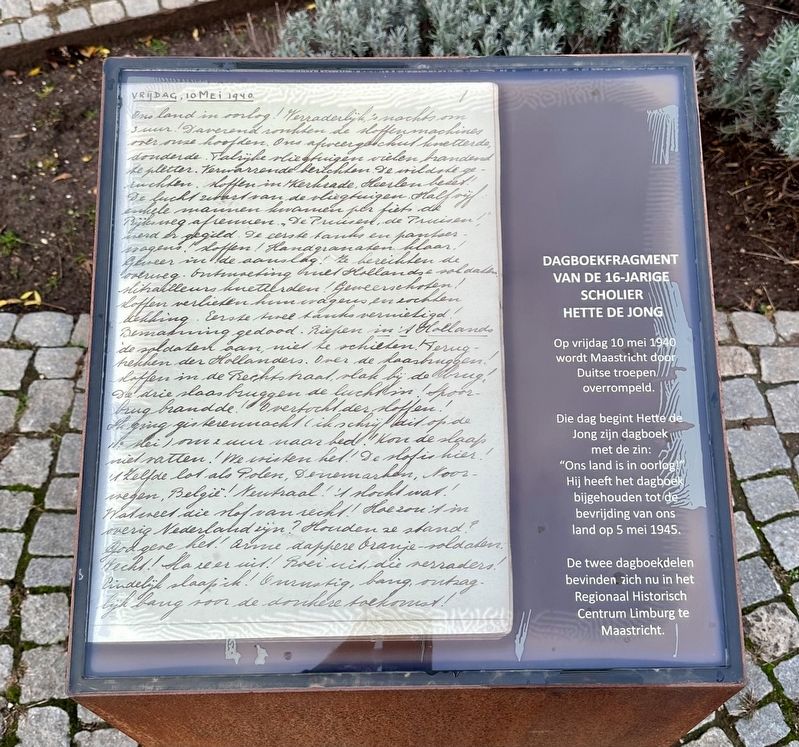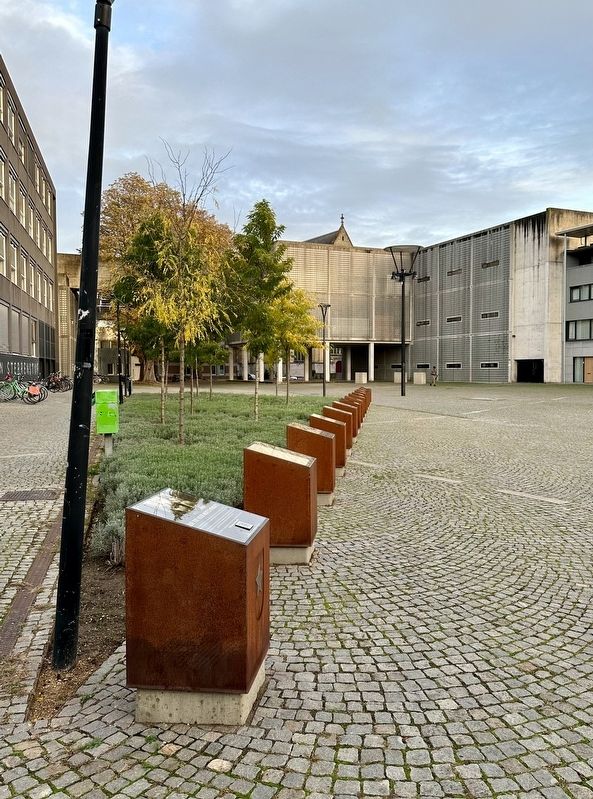Kommelkwartier in Maastricht, Limburg, Netherlands — Northwestern Europe
Herdenkingsplein (02): Dagsboekfragment / Diary Excerpt
Inscription.
Op vrijdag 10 mei 1940 wordt Maastricht door Duitse troepen overrompeld.
Die dag begint Hette de Jong zijn dagboek met de zin: "Ons land is in oorlog!" Hij heeft het dagboek bijgehouden tot de bevrijding van ons land op 5 mei 1945.
De twee dagboekdelen bevinden zich nu in het Regionaal Historisch Centrum Limburg te Maastricht.
Diary Excerpt of the 16-Year Old Student Hette De Jong
On Friday, May 10, 1940, Maastricht was overrun by German troops.
That day, Hette de Jong begins his diary with the sentence: "Our country is at war!" He kept the diary until the liberation of our country on May 5, 1945.
The two diary volumes are now in the Regional Historical Center Limburg in Maastricht.
Erected 2022.
Topics. This memorial is listed in these topic lists: Arts, Letters, Music • War, World II. A significant historical date for this entry is May 10, 1940.
Location. 50° 50.936′ N, 5° 40.924′ E. Marker is in Maastricht, Limburg. It is in Kommelkwartier. Memorial is on Herdenkingsplein, on the right when traveling west. Touch for map. Marker is in this post office area: Maastricht, Limburg 6211 PX, Netherlands. Touch for directions.
Other nearby markers. At least 8 other markers are within walking distance of this marker. Herdenkingsplein (03): Duitse Colonnes / German Convoy (here, next to this marker); Herdenkingsplein (01): Zo Tot Veer Noets Vergete / So That We Do Not Forget (here, next to this marker); Herdenkingsplein (04): Bruggen Opgeblazen / Blown up Bridges (here, next to this marker); Herdenkingsplein (05): Hakenkruizen in de Grote Staat / Swastikas over the Grote Staat (here, next to this marker); Herdenkingsplein (06): Persoonsregistratie / Personal Registration (here, next to this marker); Herdenkingsplein (07): Schuilgelegenheid / Shelter (a few steps from this marker); Herdenkingsplein (08): ‘Op de Bon’ / Food Coupons (a few steps from this marker); Herdenkingsplein (09): Arbeidsbureau Batterijstraat / Batterijstraat Employment Office (a few steps from this marker). Touch for a list and map of all markers in Maastricht.
Also see . . . The Lost Diaries of War (New York Times, April 15, 2020). Full title and subtitle: “The Lost Diaries of War - Volunteers are helping forgotten Dutch diarists of WWII to speak at last. Their voices, filled with anxiety, isolation and uncertainty,
resonate powerfully today.” An article discussing the efforts to transcribe and disseminate Dutch diaries from WWII. Includes diary segments and photos.
Excerpt: … But unlike Frank’s diary, most of these accounts never surfaced again. Scholars read them once to inventory them, then shelved them — powerful but mute witnesses to the horrors of war. Now, though, the Dutch have launched an effort to transcribe the handwritten or typed pages into digital documents, ready for posting on the archive’s website. More than 90 have already been fully transcribed.(Submitted on February 10, 2024.)
“The most valuable diaries are the ones where they wrote about their own feelings, or conversations they had on the street or with family, or how they felt about the persecution of the Jews,” said Rene Kok, a researcher with the Dutch archive, now known as NIOD Institute for War, Holocaust and Genocide Studies. “The best diarists are the ones with courage.”
Credits. This page was last revised on February 10, 2024. It was originally submitted on February 10, 2024, by Andrew Ruppenstein of Lamorinda, California. This page has been viewed 45 times since then. Photos: 1, 2. submitted on February 10, 2024, by Andrew Ruppenstein of Lamorinda, California.

